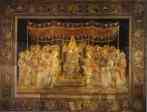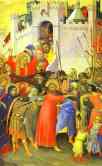Simone Martini Biography
Simone’s projected date of birth is based on a 16th-century source, but may well be accurate, even though the date of his first signed work, the fresco of the Maestà in the Palazzo Pubblico in Siena, is a relatively late 1316. The stylistic diversity of his works is so wide that it has proved impossible so far to table their chronology. It is not inconceivable, for example, that the Maestà in Siena, the devotional panels comprising the Orsini Polyptych, (The Annunciation, The Road to Calvary, The Crucifixion, The Deposition, The Entombment), and the altarpieces in an old fashioned style which he executed for Pisa and Orvieto, are all in fact contemporaneous. Though it is necessary to mention that some art historians date Orsini Polyptych to later period, c. 1335-44. Whatever the case, Simone’s works indicate that he had studied Duccio, Giotto and French art with the same intensity. He also drew inspiration from his sculptor colleagues, and in particular Giovanni Pisano.
We can be certain that, by c. 1315, Simone must have already been a famous master. Otherwise it is most unlikely that he would have been awarded the Maestà commission in Siena. Nor would we find him, in 1317, being paid an astonishingly high salary in the service of Robert d’Anjou, who even raised him to the nobility. The Angevin Kings of Naples and their supporters were his major patrons during these years. Together with his large workshop, he also worked for the City of Siena and various other clients in central Italy.
In 1317-19, Simone decorated the St. Martin Chapel in San Francesco, Assisi. The decoration of the Lower church in Assisi was funded by a donation from a Franciscan cardinal, Montefiori, who died in 1312. The cardinal had been an ardent supporter of the house of Anjou, in whose service he had helped with the acquisition of Hungary. The cycle comprises ten scenes from the life of St. Martin, starting with the episode in which he divides his cloak with the beggar and finishing with his death. Despite its church setting, the cycle is a work of court art; painted by Simone Martini, himself ennobled while in Anjou service, it glorifies the French ruling house through the figure of St. Martin, who had close connections with both France and Hungary.
Simone introduced some of the most significant innovations in the genre of the devotional panel, such as the so-called Madonna dell’Umiltá (Mary kneeling and at the same time suckling the Child). From 1339 at the latest he is documented in Avignon, where he worked for Cardinal Stefaneschi and other senior clergymen. While he left a school of followers both in Siena and Avignon, some of his achievements became the common property of all 14th-century art. Already highly praised in his lifetime – including by Petrarch, for whom he executed several works – his fame lived on not only in Siena, where in the early 15th century he was considered the greatest Sienese painter of all, but also, for a long time, north of the Alps. With Simone, the Sienese example spread across the austere Gothic painting of the North and had a lasting effect in France.
Bibliography
The Art of the Italian Renaissance. Architecture. Sculpture. Painting. Drawing. Könemann. 1995.
Monumental Painting of Italian Renaissance by I. Smirnova. Moscow. 1987.
Simone Martini by Enrico Castelnuovo. Riverside Book Company, 1990.
Simone Martini Complete Edition by Andrew Martindale. Phaidon Press, 1994.
- Maestà.

1317. Fresco. Palazzo Pubblico, Sala del Mappamondo, Siena, Italy.
- The Road To Calvary.

c. 1315 (or later). Part of the Orsini Polyptych. Tempera on wood. Louvre, Paris, France. Read Note.
- The Deposition.

c. 1315 (or later). Part of the Orsini Polyptych. Tempera on wood. Koninklijk Museum voor Schone Kunsten, Antwerp, Belgium. Read Note.